初中英语语法——一般过去时知识点总结归纳
初中英语一般过去时知识点汇总
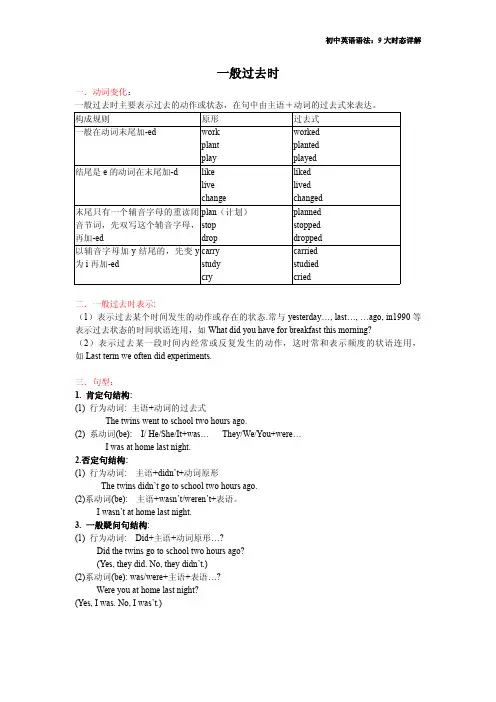
一般过去时一.动词变化:一般过去时主要表示过去的动作或状态,在句中由主语+动词的过去式来表达。
构成规则原形过去式一般在动词末尾加-ed workplantplay worked planted played结尾是e的动词在末尾加-d likelivechange liked lived changed末尾只有一个辅音字母的重读闭音节词,先双写这个辅音字母,再加-ed plan(计划)stopdropplannedstoppeddropped以辅音字母加y结尾的,先变y 为i再加-ed carrystudycrycarriedstudiedcried二.一般过去时表示:(1)表示过去某个时间发生的动作或存在的状态.常与yesterday…,last…,…ago,in1990等表示过去状态的时间状语连用,如What did you have for breakfast this morning?(2)表示过去某一段时间内经常或反复发生的动作,这时常和表示频度的状语连用,如Last term we often did experiments.三.句型:1.肯定句结构:(1)行为动词:主语+动词的过去式The twins went to school two hours ago.(2)系动词(be):I/He/She/It+was…They/We/You+were…I was at home last night.2.否定句结构:(1)行为动词:主语+didn’t+动词原形The twins didn’t go to school two hours ago.(2)系动词(be):主语+wasn’t/weren’t+表语。
I wasn’t at home last night.3.一般疑问句结构:(1)行为动词:Did+主语+动词原形…?Did the twins go to school two hours ago?(Yes,they did.No,they didn’t.)(2)系动词(be):was/were+主语+表语…?Were you at home last night?(Yes,I was.No,I was’t.)4.特殊疑问句结构:特殊疑问词(what,how often,which,where,who)+一般疑问句?★频度副词:通常用于一般现在时或一般过去时,频率副词常放在行为动词之前,系动词、情态动词或助动词之后。
2024年初中英语语法考点归纳之一般过去时
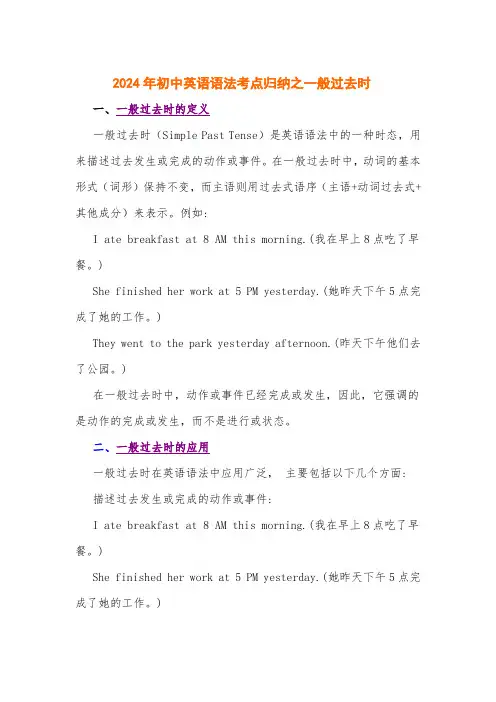
2024年初中英语语法考点归纳之一般过去时一、一般过去时的定义一般过去时(Simple Past Tense)是英语语法中的一种时态,用来描述过去发生或完成的动作或事件。
在一般过去时中,动词的基本形式(词形)保持不变,而主语则用过去式语序(主语+动词过去式+其他成分)来表示。
例如:I ate breakfast at 8 AM this morning.(我在早上8点吃了早餐。
)She finished her work at 5 PM yesterday.(她昨天下午5点完成了她的工作。
)They went to the park yesterday afternoon.(昨天下午他们去了公园。
)在一般过去时中,动作或事件已经完成或发生,因此,它强调的是动作的完成或发生,而不是进行或状态。
二、一般过去时的应用一般过去时在英语语法中应用广泛,主要包括以下几个方面: 描述过去发生或完成的动作或事件:I ate breakfast at 8 AM this morning.(我在早上8点吃了早餐。
)She finished her work at 5 PM yesterday.(她昨天下午5点完成了她的工作。
)They went to the park yesterday afternoon.(他们昨天下午去了公园。
)在描述过去的动作或事件时,一般过去时可以用于表示过去的经验、习惯、行为等,例如:I usually go for a walk after dinner every night.(我每天晚上吃完晚饭后都会去散步。
)She always helps her mother with the dishes after school.(放学后,她总是帮助妈妈洗碗。
)They played basketball after work yesterday.(昨天下班后,他们打了篮球。
)表示过去的状态或存在:表示过去的状态或存在时,一般过去时常常用来表示在过去某个时间点发生或完成的动作或状态。
英语过去式知识点归纳
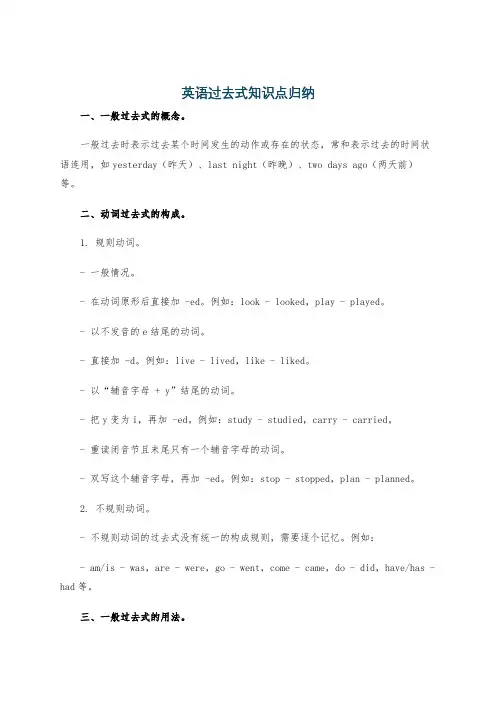
英语过去式知识点归纳一、一般过去式的概念。
一般过去时表示过去某个时间发生的动作或存在的状态,常和表示过去的时间状语连用,如yesterday(昨天)、last night(昨晚)、two days ago(两天前)等。
二、动词过去式的构成。
1. 规则动词。
- 一般情况。
- 在动词原形后直接加 -ed。
例如:look - looked,play - played。
- 以不发音的e结尾的动词。
- 直接加 -d。
例如:live - lived,like - liked。
- 以“辅音字母 + y”结尾的动词。
- 把y变为i,再加 -ed。
例如:study - studied,carry - carried。
- 重读闭音节且末尾只有一个辅音字母的动词。
- 双写这个辅音字母,再加 -ed。
例如:stop - stopped,plan - planned。
2. 不规则动词。
- 不规则动词的过去式没有统一的构成规则,需要逐个记忆。
例如:- am/is - was,are - were,go - went,come - came,do - did,have/has - had等。
三、一般过去式的用法。
1. 表示过去某个特定时间发生的动作或存在的状态。
- I saw a movie last Sunday.(上周日我看了一部电影。
)- He was at home yesterday.(他昨天在家。
)2. 表示过去经常或反复发生的动作。
- When I was a child, I often played football in the park.(当我是个孩子的时候,我经常在公园里踢足球。
)四、一般过去式的句式结构。
1. 肯定句。
- 主语+动词过去式+其他。
例如:- She visited her grandparents last weekend.(她上周末去看望她的祖父母了。
)2. 否定句。
- 主语+did not (didn't)+动词原形+其他。
一般过去时知识点归纳
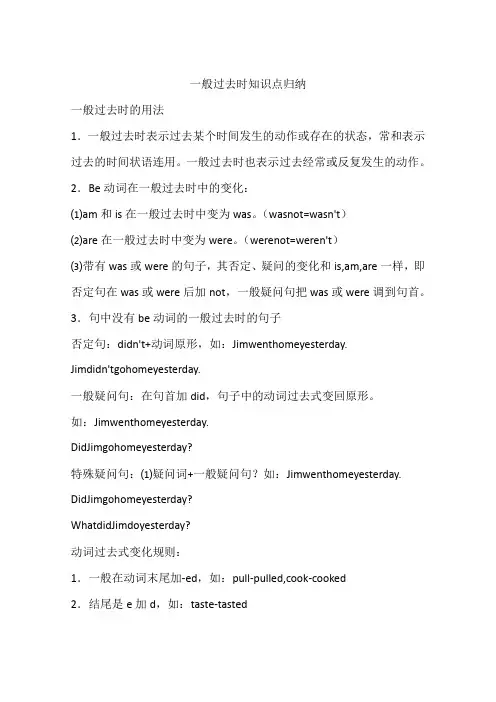
一般过去时知识点归纳一般过去时的用法1.一般过去时表示过去某个时间发生的动作或存在的状态,常和表示过去的时间状语连用。
一般过去时也表示过去经常或反复发生的动作。
2.Be动词在一般过去时中的变化:⑴am和is在一般过去时中变为was。
(wasnot=wasn't)⑵are在一般过去时中变为were。
(werenot=weren't)⑶带有was或were的句子,其否定、疑问的变化和is,am,are一样,即否定句在was或were后加not,一般疑问句把was或were调到句首。
3.句中没有be动词的一般过去时的句子否定句:didn't+动词原形,如:Jimwenthomeyesterday.Jimdidn'tgohomeyesterday.一般疑问句:在句首加did,句子中的动词过去式变回原形。
如:Jimwenthomeyesterday.DidJimgohomeyesterday?特殊疑问句:⑴疑问词+一般疑问句?如:Jimwenthomeyesterday. DidJimgohomeyesterday?WhatdidJimdoyesterday?动词过去式变化规则:1.一般在动词末尾加-ed,如:pull-pulled,cook-cooked2.结尾是e加d,如:taste-tasted3.末尾是辅音字母加一个元音字母和一个辅音字母的重读闭音节,应双写末尾的辅音字母,再加-ed,如:stop-stopped4.以“辅音字母+y”结尾的,变y为i,再加-ed,如:study-studied 5.不规则动词过去式:词义现在(原形)过去是am,is(be)was是are(be)were成为becomebecame开始beginbegan弯曲bendbent 吹blow blew 买buy bought 能can could 捕捉catch caught 选择choose chose 来come came 切cutcut做do,doesdid画drawdrew饮drinkdrank吃eatate词义现在(原形)过去感觉feelfelt发现findfound飞flyflew忘记forget forgot 得到getgot给give gave走go went成长grow grew有have,hashad听hearheard受伤hurthurt保持keepkept知道knowknew学习learn learned,learnt 允许,让letlet躺lielay。
初中英语语法——一般过去时知识点总结归纳
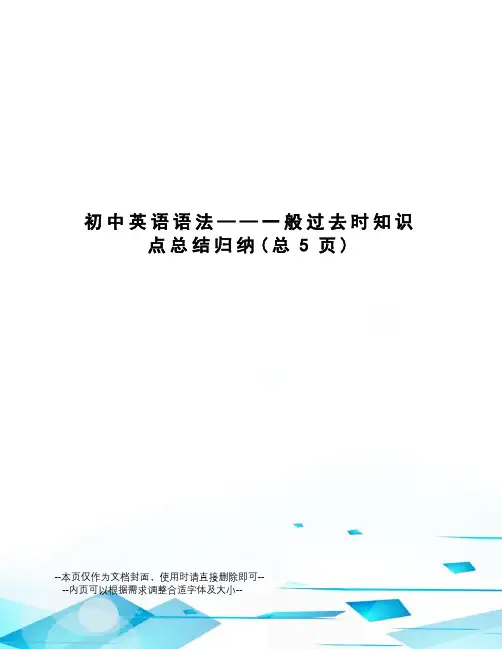
初中英语语法——一般过去时知识点总结归纳(总5页)--本页仅作为文档封面,使用时请直接删除即可----内页可以根据需求调整合适字体及大小--初中英语语法——一般过去时知识点总结归纳表示过去发生的动作或事件,常和表示过去的时间状语连用,如yesterday, last night, the day before yesterday, 3 days ago...含有be动词的句子,将be动词变为过去式。
am, is的过去式为was, are的过去式为were:I was at the butcher's.You were a student a year ago.The teacher was very beautiful ten years ago.★变否定句在be动词后面加notI was not at the butcher's.You were not a student a year ago.The teacher was not very beautiful ten years ago.★变疑问句将be动词移动到句首Were you at the butcher's?Were you a student a year ago?Was the teacher very beautiful ten years ago?★肯定回答否定回答Yes, I was. / No, I was not.Yes, you were. / No, you were not.Yes, he/she was. / No, he/she was not.★特殊疑问句What did you do(必背)不含有be动词的句子,将动词变为过去式:I finished my homework yesterday.The boy went to a restaurant.The Sawyers lived at King Street a year ago.★变疑问句在句首加did,动词变为原型Did you finish your homework yesterday?Did the boy go to a restaurant?Did the Sawyers live at King Street a year ago?★变否定句在主语和动词之间加did notI did not finish my homework yesterday.The boy did not go to a restaurant.The Sawyers did not live at King Street a year ago.★肯定回答及否定回答Yes, I did. / No, I didn't.Yes, he did. / No, he didn't.Yes, they did. / No, they did not.知识提升:(1)表示过去某个特定时间或某一段时间发生的动作或情况。
(完整word版)一般过去时详解(重点)

一、一般过去时的概念:一般过去时用来表示过去某一时间内发生的动作或存在的状态以及过去习惯性、反复性的动作。
谓语动词要用动词的过去式,常和表示过去的时间状语连用,如yesterday昨天、last night昨晚、last week上周、last year去年,等。
二、一般过去时的结构:(可分三类不同的结构)1.Be动词的一般过去时在没有实义动词的句子中使用be动词, am is 的过去式为was; are的过去式为were肯定句式:主语 + be(was , were) + 其它.否定句式:主语 + be(was , were) + not + 其它.一般疑问句:Be(was , were) + 主语 + 其它?注:在这种构成中,be动词有人称和数的变化,即要根据主语选用was / were。
Be动词分为单数和复数,was是表示单数,were是表示复数。
2. 实义动词的一般过去时态肯定句要使用动词的过去式,否定句和疑问句要使用助动词do和 does 的过去式 did.肯定句式:主语 + 动词(过去式)+ 其它否定句式:主语 + didn’t + 动词(原形)+ 其它【did not = didn’t】一般疑问句:Did + 主语+ 动词(原形)+ 其它【do , does的过去时均为did】?注:did和didn’t是构成一般过去时的助动词,其特点是要在其后跟动词的原形。
3. 情态动词的一般过去时态含有情态动词的一般过去时与含有Be动词的一般过去时,是十分相似,请注意观察。
肯定句式:主语 + 情态动词 + 其它.否定句式:主语 + 情态动词 + not + 其它.一般疑问句:情态动词 + 主语 + 其它?注:情态动词的过去式:can→could , may→might , must→must,will-would,should-should.4.特殊疑问句式:特殊疑问词+be过去式+主语+其他?特殊疑问词+情态助动词过去式+主语+动词原形+其他?特殊疑问词+do/does过去式+主语+动词原形+其他?What was your former name?你以前叫什么名字?Why did he late for school last Monday?上星期一他为什么迟到?What could she do twenty years ago?20年前她能做什么?三、一般过去时的判断标志词yesterday , the day before yesterday , last + 时间 , this morning时间 + ago , just now , a moment ago , in + 过去的时间 .四、规则动词的过去式1.一般情况下,在动词原形后面加-ed。
初中英语知识点总结一般过去时
初中英语知识点总结一般过去时一、一般过去时的用法:一般过去时表示过去发生或完成的动作、存在的状态或做过的事情。
1.表示过去一些时间发生的动作或存在的状态:- I played soccer yesterday.(我昨天踢足球。
)- He lived in Beijing when he was young.(他年轻时住在北京。
)2.表示过去的习惯性动作或经常发生的动作:- When I was a child, I always went to bed early.(我小的时候总是早睡。
)3.表示过去的客观事实或真理:- The dinosaurs died out millions of years ago.(恐龙在几百万年前灭绝了。
)- She didn't know the answer to the question.(她不知道问题的答案。
)4.表示过去的心理活动、愿望或打算等:- I wanted to be a doctor when I was young.(我年轻时想做一名医生。
)- He hoped to go to the park with his friends.(他希望和朋友去公园。
)二、一般过去时的构成:1.肯定句式:主语+动词的过去式+其他成分- I played basketball last week.- She lived in London for three years.- They watched a movie at the cinema yesterday.2.否定句式:主语 + did not / didn't + 动词原形 + 其他成分- I didn't play basketball last week.- She didn't live in London for three years.- They didn't watch a movie at the cinema yesterday.3.疑问句式:Did + 主语 + 动词原形 + 其他成分?- Did you play basketball last week?- Did she live in London for three years?- Did they watch a movie at the cinema yesterday?三、一般过去时的特殊情况:1.动词过去式的构成规则:a) 一般情况下,动词的过去式在词尾加上-ed:walk - walked(走)talk - talked(说话)play - played(玩)b)以字母e结尾的动词,在词尾只加-d:dance - danced(跳舞)c) 以辅音字母+y结尾的动词,将y变为i,再加-ed:study - studied(学习)d) 以重读闭音节结尾,末尾只有一个辅音字母的动词,双写这个辅音字母,再加-ed:stop - stopped(停止)plan - planned(计划)2.部分动词的过去式不规则,需要记忆:be - was / were(是)have - had(有)go - went(去)do - did(做)write - wrote(写)see - saw(看见)eat - ate(吃)drink - drank(喝)take - took(拿)四、表示一般过去时的时间状语:1.表示过去一些时间的状语:yesterday(昨天)last week(上星期)two days ago(两天前)2.表示过去的时间段的状语:when I was young(我年轻时)in my childhood(在我童年时)in the past(在过去)3.表示过去曾经做过的动作的状语:once(一次)五、注意事项:1. 一般过去时的句子中,谓语动词要用过去式,但be动词有时会用was或were。
一般过去时的知识点归纳
一般过去时的知识点归纳一般过去时是表示过去某一时间或一段时间内所发生的动作或状态的时态,一般用于描述过去发生的事情,它的基本结构是主语+ 动词的过去式。
以下是一般过去时的知识点归纳:1. 动词的过去式:在大多数情况下,一般过去时的动词需要加上-ed结尾。
但有些动词过去式并不是-ed,例如:go-went,eat-ate,come-came等。
2. be动词的过去式:be动词的过去式分为was和were,was用于第一人称单数和第三人称单数,were用于第二人称单数、第一人称复数和第三人称复数。
3. 常用时间状语:在一般过去时的句子中,常常需要使用时间状语来表明动作发生的过去时间,例如:yesterday,last night,last Monday等。
4. 特殊疑问句和否定句:一般过去时的特殊疑问句的结构和现在时基本一致,只是把be动词和其他动词的过去式放在句首。
否定句的结构为主语+ did not / didn't + 动词原形。
5. 不规则动词的过去式:有一些动词的过去式和原形没有任何规律可言,需要特别记住,例如:bring-brought,buy-bought,catch-caught等。
6. 短语动词的过去式:短语动词的过去式一般是由动词原形和前缀或后缀组成,例如:give up-gave up,look for-looked for,break down-broke down等。
7. 时态转换:如果句子中已经使用了过去式的时间状语,那么主语动词不必再使用过去式,而可以使用现在完成式或过去完成式等。
8. 多重动作的描述:当一句话中有多个动作需要被描述时,需要注意动作发生的先后顺序和时态的运用,通常需要使用时间状语、连接词或使用逗号分开多个动作。
八年级上册英语语法《一般过去时》知识点整理
一般过去时1.一般过去时:表示过去时间发生的动作或存在的状态。
2.一般过去时结构:1)Be动词:主语+Be的过去式(was /were)+其它。
2)实义动词:主语+V-ed+其它。
3.一般过去时的标志词:yesterday昨天 yesterday morning 昨天上午 last year去年just now刚才two days ago两天前in 1999在1999年情景提示等。
4. 一般过去时的肯定式、否定式、疑问式及简略回答。
1)Be动词:(1)肯定句:主语+was/were +其它 .I was late yesterday. 昨天我迟到了。
We were primary students 5 years ago.(2)否定句:主语+was /were+not +其它.We weren't late yesterday. (我们昨天没迟到)(3)一般问句:be动词提前。
Was/Were + 主语+其它?I was ill yesterday. (改一般疑问句)→Were you ill yesterday? (你昨天病了吗?)肯定回答:Yes, I was. (是的,我病了。
)否定回答:No, I wasn't. (不,我没病。
)(4)特殊问句:对谓语动词进行提问的:疑问词+was/were+主语+其它(一般疑问句)?I was born in 1997.→When were you born? 你是什么时候出生的?2)实义动词:(1)肯定句:主语+V-ed +其它。
I called up my good friend just now.(2)否定句: 主语+didn’t +V原形+其它I didn’t argue with Tom last week.(3)一般问疑句:Did +主语+ V原形+其它?I bought a souvenir in 2010. (改一般疑问句)→Did you buy a souvenir in 2010?肯定回答:Yes, I did.否定回答:No, I didn’t.(4)特殊疑问句: 疑问词+did +主语+ V原形+其它?I went to HongKong last year.→Where did you go to HongKong last year?5. 变化规则(1)、规则动词的变化规则:(1)一般情况下在词尾直接加ed。
初中英语知识点归纳一般过去时的用法
初中英语知识点归纳一般过去时的用法一、一般过去时的定义和用法一般过去时用来表示过去发生的动作或存在的状态。
在一般过去时中,动词的过去式通常用于陈述句中,而表示过去发生的时间状语词也常常与一般过去时连用。
二、一般过去时的构成1.对于大多数动词,过去式是在动词原形结尾加上-ed,例如:- walk - walked- play - played- watch - watched2.以不发音的e结尾的动词,过去式只需加上-d,例如:- live - lived- love - loved3.以辅音字母+y结尾的动词,将y变为i,再加-ed,例如:- study - studied- try - tried4.以一个元音字母加一个辅音字母结尾的重读闭音节动词,双写最后一个辅音字母,再加-ed,例如:- stop - stopped- plan - planned注意:有些动词的过去式形式与原形一样,例如:- put - put- cut - cut三、一般过去时的用法1.表示过去某个时间发生的动作或事件,例如:- I went to the park yesterday.- They finished their homework last night.2.表示过去存在的状态,例如:- She was a nice girl when she was young.- It was sunny yesterday.3.表示过去的习惯或经常性动作,例如:- When I was young, I played basketball every day.- They often went fishing on weekends.4.在宾语从句中,当主句是过去时,宾语从句的动词也要用一般过去时,例如:- He said that he watched a movie last night.- She told me that she visited her grandparents on the weekend.5.与表示过去具体时间的状语连用,例如:- I saw him two days ago.- We had a great time at the party last week.四、一般过去时的注意事项1.注意动词的变化形式,特别是不规则动词的过去式,需要进行记忆和练习。
- 1、下载文档前请自行甄别文档内容的完整性,平台不提供额外的编辑、内容补充、找答案等附加服务。
- 2、"仅部分预览"的文档,不可在线预览部分如存在完整性等问题,可反馈申请退款(可完整预览的文档不适用该条件!)。
- 3、如文档侵犯您的权益,请联系客服反馈,我们会尽快为您处理(人工客服工作时间:9:00-18:30)。
初中英语语法——一般过去时知识点总结归纳表示过去发生的动作或事件,常和表示过去的时间状语连用,如yesterday, last night, the day before yesterday, 3 days ago...
含有be动词的句子,将be动词变为过去式。
am, is的过去式为was, are的过去式为were:
I was at the butcher's.
You were a student a year ago.
The teacher was very beautiful ten years ago.
★变否定句在be动词后面加not
…
I was not at the butcher's.
You were not a student a year ago.
The teacher was not very beautiful ten years ago.
★变疑问句将be动词移动到句首
Were you at the butcher's
Were you a student a year ago
Was the teacher very beautiful ten years ago
】
★肯定回答否定回答
Yes, I was. / No, I was not.
Yes, you were. / No, you were not.
Yes, he/she was. / No, he/she was not.
★特殊疑问句
What did you do(必背)
?
不含有be动词的句子,将动词变为过去式:
I finished my homework yesterday.
The boy went to a restaurant.
The Sawyers lived at King Street a year ago.
;
★变疑问句在句首加did,动词变为原型
Did you finish your homework yesterday
Did the boy go to a restaurant
Did the Sawyers live at King Street a year ago
★变否定句在主语和动词之间加did not
I did not finish my homework yesterday.
!
The boy did not go to a restaurant.
The Sawyers did not live at King Street a year ago.
★肯定回答及否定回答
Yes, I did. / No, I didn't.
Yes, he did. / No, he didn't.
Yes, they did. / No, they did not.
—
知识提升:
(1)表示过去某个特定时间或某一段时间发生的动作或情况。
►. We visited the school last spring.
►. I went to school by bike when I was in middle school.
►. China was founded in 1949.
(2)在表示时间或条件等的状语从句中代替过去将来时。
►. She told me that she would not go with us if it rained the next day.
►. They would not leave until she came back.
:
►. My friend promised to marry me once she made her final decision.
一般过去时,现在时和过去时的几组差异:(别以为这很简单,下面的差异你不一定明白。
)
►. Her brother was a chemist.(已去世)
►. Her brother is a chemist.(尚健在)
►. That's all I had to say.(话已说完)
►. That's all I have to say.(言之未尽)
►. It was so nice to see you.(离别时用)
►. It is so nice to see you.(见面时用)
~
►. Jane did a lot of work this morning.(已是当天下午或晚上)
►. Jane has done a lot of work this morning.(仍是上午)[本句现在完成时,此乃后话!]
测试精编I:(用所给动词的正确进态填空)。
1. Yesterday I ________ (think) that you were not in Beijing.
2. Alice usually ________ (sit) in the front of the classroom, but she ________ (sit) at the back this morning.
3. He ________ (tell) the news to us three days ago.
4. He________ (begin) to teach Chinese in 1990.
5. she would not telephone me if she ________ (have) no time.
测试精编II
;
1. They ________ the trip until the rain stopped.
A. continued
B. didn't continue
C. hadn't continued
D. would continue
2. The local peasants gave the soldiers clothes and food without which they ________ of hunger and cold.(without 在这里表条件,你知道吗)
A. would die
B. will die
C. would be dead
D. would have died
3. It was not until then that I came to know that the earth ________ around the sun.
A. moved
B. has moved
C. will move
D. moves
4. When all those present ________ he began his lecture.(重点题)
A. sit
B. set
C. seated
D. were seated
5. If I had had time, I would have written to you. But in fact I ________ not.
A. have
B. would have
C. had
D. had had KEYS
1. thought
2. sits, sat
3. told
4. began
5. had 1. B 2. A 3. D 4. D 5. C。
